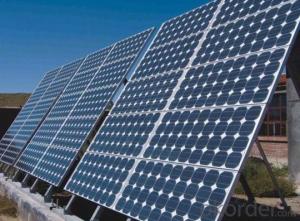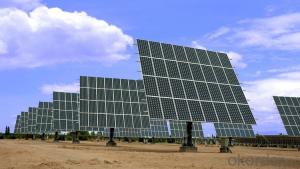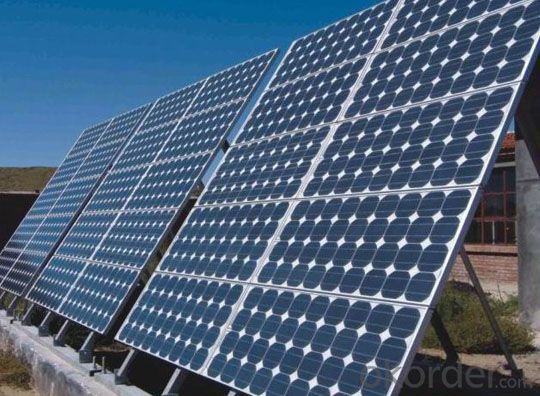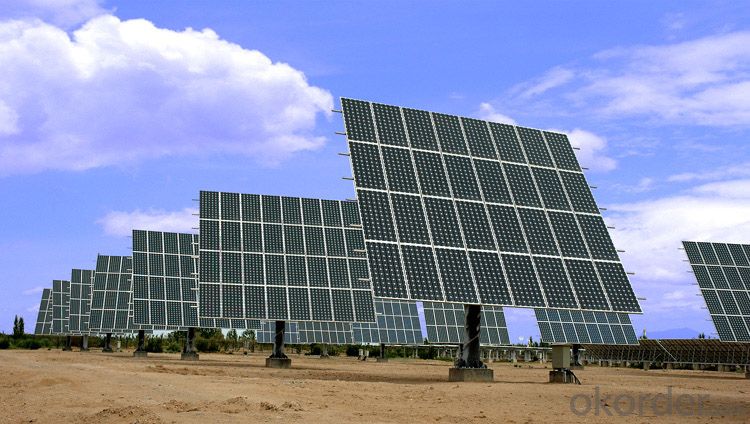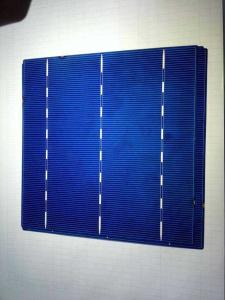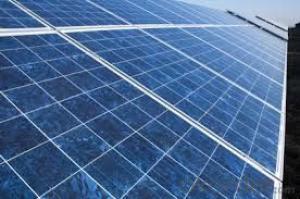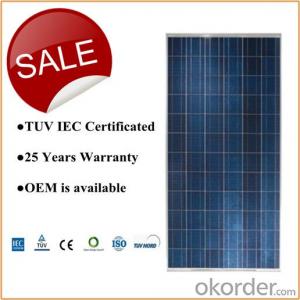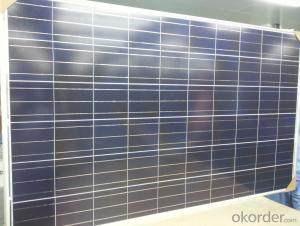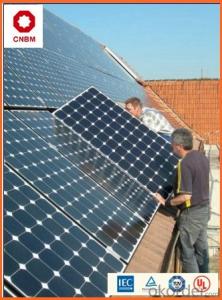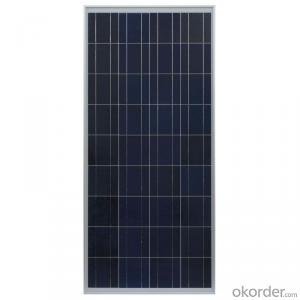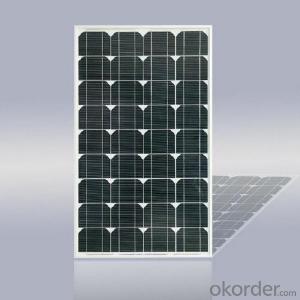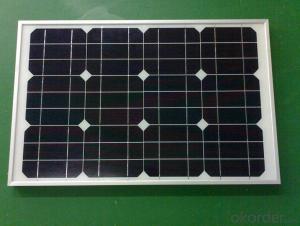Solar Cells Canada - Sales Solar Panels 280w Poly 72pcs Cells 36v
- Loading Port:
- China Main Port
- Payment Terms:
- TT OR LC
- Min Order Qty:
- -
- Supply Capability:
- 10000000000000 watt/month
OKorder Service Pledge
Quality Product, Order Online Tracking, Timely Delivery
OKorder Financial Service
Credit Rating, Credit Services, Credit Purchasing
You Might Also Like
Quick Details
| Place of Origin: | Guangdong China (Mainland) | Brand Name: | sunshine | Model Number: | sy-280p |
| Material: | Polycrystalline Silicon | Size: | 1960*980*40mm | Number of Cells: | 72PCS |
| Max. Power: | 280W | VOC: | 36V |
Packaging & Delivery
| Packaging Detail: | Crate |
| Delivery Detail: | 30 |
Specifications
1, A grade solar cell
2,Life of 20-35 years
3,Super quality competitve price
4,International Standard
solar panels 280W poly Specification
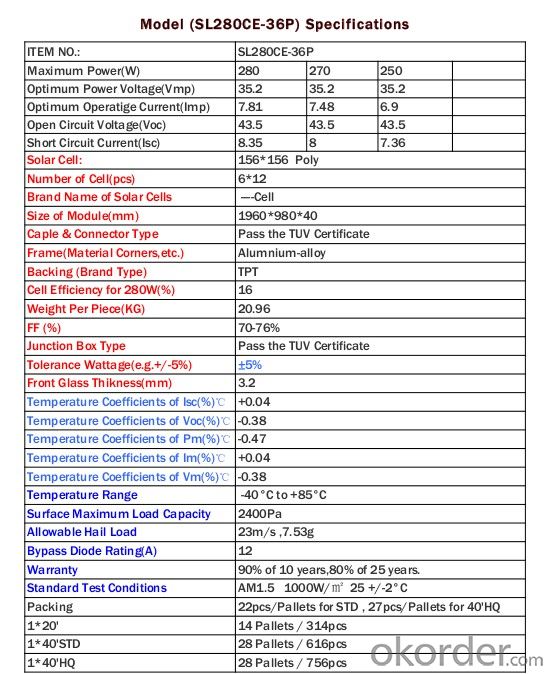
- Q: Can solar cells be used in developing countries?
- Yes, solar cells can be used in developing countries. They offer a sustainable and renewable source of energy that can be harnessed even in remote areas without access to electricity grids. Solar cells can provide clean and affordable electricity, helping to improve living conditions, foster economic growth, and reduce dependence on fossil fuels. Additionally, the decreasing costs and increasing efficiency of solar technology make it an increasingly viable option for developing countries.
- Q: Can solar cells be used in areas with high pollution?
- Yes, solar cells can still be used in areas with high pollution. While pollution can reduce the efficiency of solar cells by blocking sunlight, advancements in technology have made solar panels more resilient. Additionally, regular maintenance and cleaning can help mitigate the impact of pollution on solar panels.
- Q: How do solar cells perform in areas with frequent tornadoes?
- Solar cells can perform well in areas with frequent tornadoes as long as they are properly designed and installed to withstand extreme weather conditions. While tornadoes can potentially damage or destroy solar panels, advancements in technology have made solar cells more resilient. Additionally, solar panels can be reinforced or mounted securely to minimize the risk of damage. It is important to consider the specific location and design of the solar installation to ensure it can withstand tornadoes and other severe weather events.
- Q: How do solar cells perform in areas with high winds?
- Solar cells can perform well in areas with high winds as long as they are properly installed and secured. However, excessive wind speeds can potentially damage or displace the solar panels, affecting their efficiency. To mitigate this, appropriate mounting systems and anchoring techniques can be used to ensure the stability and durability of solar installations in windy areas.
- Q: Can solar cells be used to power street lights?
- Yes, solar cells can be used to power street lights. Solar-powered street lights utilize photovoltaic panels to convert sunlight into electricity, which is then stored in batteries. This stored energy is used to power the street lights during the night, providing an eco-friendly and cost-effective lighting solution for public spaces.
- Q: What is the impact of solar cells on wildlife?
- The impact of solar cells on wildlife is generally minimal and beneficial. Solar cells produce clean energy without emitting harmful pollutants or greenhouse gases, reducing air and water pollution that can negatively affect wildlife habitats. Additionally, solar energy infrastructure typically occupies a small footprint and can coexist with wildlife habitats, allowing animals to continue their normal behaviors. However, there have been some concerns about the potential for bird collisions with solar panels and the disruption of desert ecosystems during large-scale solar installations. Overall, compared to traditional energy sources, solar cells have a much lower impact on wildlife and contribute to a more sustainable future.
- Q: How do solar cells perform in areas with high levels of industrial emissions?
- Solar cells can still perform effectively in areas with high levels of industrial emissions. While industrial emissions can potentially reduce the overall performance of solar cells due to air pollution and particulate matter, the impact can vary depending on the specific pollutants and their concentration. Regular cleaning and maintenance of the solar panels can help mitigate any negative effects. Additionally, advancements in solar cell technology, such as anti-reflective coatings and improved efficiency, can enhance their performance even in challenging environments.
- Q: I know that solar cells are produced by DC and then converted into alternating current through the inverter, who explains why the solar cell is produced by DC?
- The electrons in the outer layer of the semiconductor nuclei are absorbed into the high energy level when they are exposed to light. The unstable electrons are returned to the semiconductor by the external circuit. The direction of the movement of the electrons in the external circuit is determined.
- Q: Whether the solar cell is light can produce electricity
- As long as it is light to, and instantly can output voltage and in the case of a loop generated current. In physics called solar photovoltaic (Photovoltaic, photo light, voltaics volts, abbreviated as PV), referred to as photovoltaic.
- Q: Can solar cells be used to power homes?
- Yes, solar cells can be used to power homes. Solar panels, made up of multiple solar cells, can convert sunlight into electricity which can then be used to power various appliances and systems in a household.
Send your message to us
Solar Cells Canada - Sales Solar Panels 280w Poly 72pcs Cells 36v
- Loading Port:
- China Main Port
- Payment Terms:
- TT OR LC
- Min Order Qty:
- -
- Supply Capability:
- 10000000000000 watt/month
OKorder Service Pledge
Quality Product, Order Online Tracking, Timely Delivery
OKorder Financial Service
Credit Rating, Credit Services, Credit Purchasing
Similar products
Hot products
Hot Searches
Related keywords
